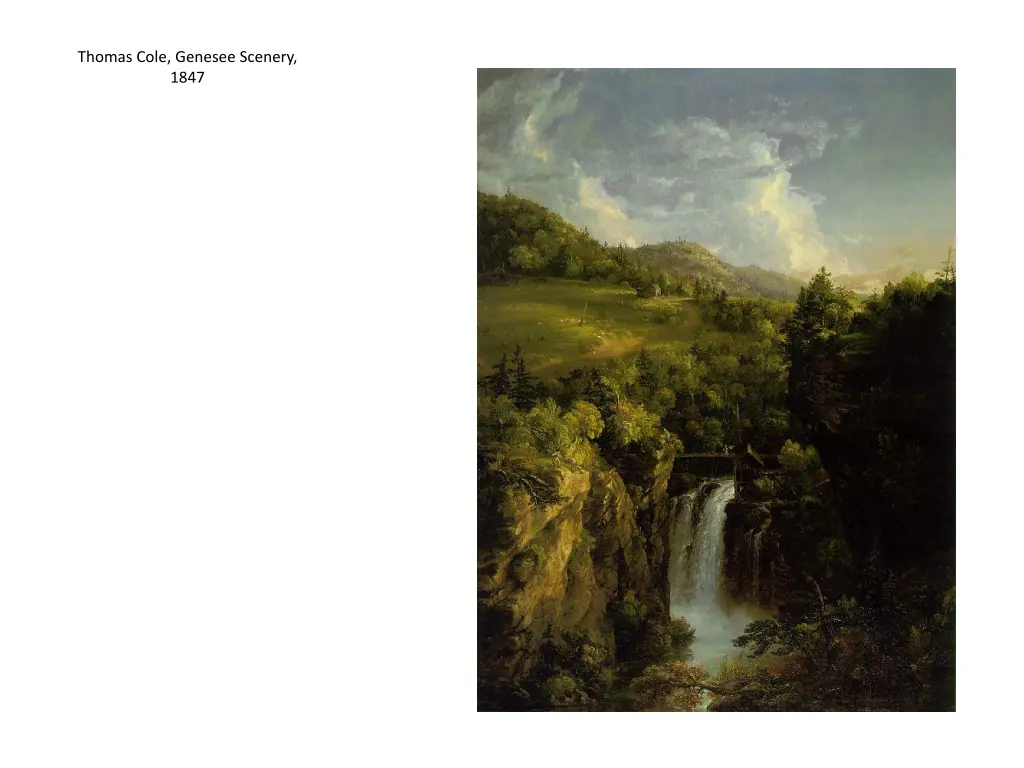
Thomas Cole and George Inness - American Landscape Painters
Explore the scenic artworks of Thomas Cole and George Inness, renowned American landscape painters from the 19th century. Discover the beauty of nature captured in their masterpieces, reflecting the tranquility and grandeur of the American landscape. Immerse yourself in a visual journey through Cole's depictions of the Genesee Valley and Catskill Mountains, alongside Inness' portrayal of Lackawanna Valley. Experience the artistry that celebrates the beauty of nature and the American wilderness.
Download Presentation

Please find below an Image/Link to download the presentation.
The content on the website is provided AS IS for your information and personal use only. It may not be sold, licensed, or shared on other websites without obtaining consent from the author. If you encounter any issues during the download, it is possible that the publisher has removed the file from their server.
You are allowed to download the files provided on this website for personal or commercial use, subject to the condition that they are used lawfully. All files are the property of their respective owners.
The content on the website is provided AS IS for your information and personal use only. It may not be sold, licensed, or shared on other websites without obtaining consent from the author.
E N D
Presentation Transcript
Thomas Cole, Notch of the White Mountains, 1839
Thomas Cole, View From Mount Holyoke, after a Thunderstorm, 1836
Dixon Ryan Fox, Jefferson Hill, 1837 These ornamented grounds lie desolate; Those stately trees that waved o'er beauteous slopes, By fellers' hands now strewed in fragments lie; The trees that bent with fruits from Eden sprung Are plucked by passers' hands, and none rebuke; These halls are desolate from silence thrilling- That dwelling fair; its very cornerstone Which time had failed to loosen, Now must yield to the improvers power; The beauteous knoll is marred to fill yon hollow; And in the room of gentle solitude Wooing to thought and fastening our hearts By interlacing tendrils to the throne Of God, our portion, here shall sound the roar Of railroad train thundering adown the gorge, All level, straight, and stiff, and stereotyped, Where nature poured her beauty's store abundant. From Dixon Ryan Fox, Jefferson Hill published originally in Catskill Messenger
Thomas Cole on the Railroad The hurry, noise, and restlessness of railroad travelling with the consequent violence done to all the natural requirements of the body are anything but conducive of health of body or serenity of mind. The body is made to be merely a sort of Tender to a locomotive car; its appetites and functions wait on a Machine which is merciless and tyrannical. Thomas Cole, Jounal, 1847
T. P. Rossiter, Opening in the Wilderness, c. 1850
Currier and Ives, Niagara Falls Suspension Bridge, 1856 The Niagara Falls Suspension Bridge, 1856
TableRock [viewpoint for falls], Harpers Weekly, Oct 2, 1858
Charles Wilson Knapp, Starrucca Viaduct, PA
Currier and Ives, Across the Continent: Westward the Course of Empire Takes its Way, 1868
Currier and Ives, Lookout Mountain Tennessee and the Chatanooga Railroad, 1866
Currier and Ives, The Express Train, c. 1850s (earliest C & I train print)
William Bradford, Of Plymouth Plantation And for the season it was winter, and they that know the winters of that cuntrie know them to be sharp and violent, and subjecte to cruell and feirce stormes, deangerous to travill to known places, much more to serch an unknown coast. Besids, what could they see but a hidious and desolate wildernes, full of wild beasts and willd men? and what multituds ther might be of them they knew not. Nether could they, as it were, goe up to the tope of Pisgah, to vew from this willdernes a more goodly cuntrie to feed their hops; for which way soever they turnd their eys (save upward to the heavens) they could have litle solace or content in respecte of any outward objects. `For summer being done, all things stand upon them with a wetherbeaten face; and the whole countrie, full of woods and thickets, represented a wild and savage heiw.






















